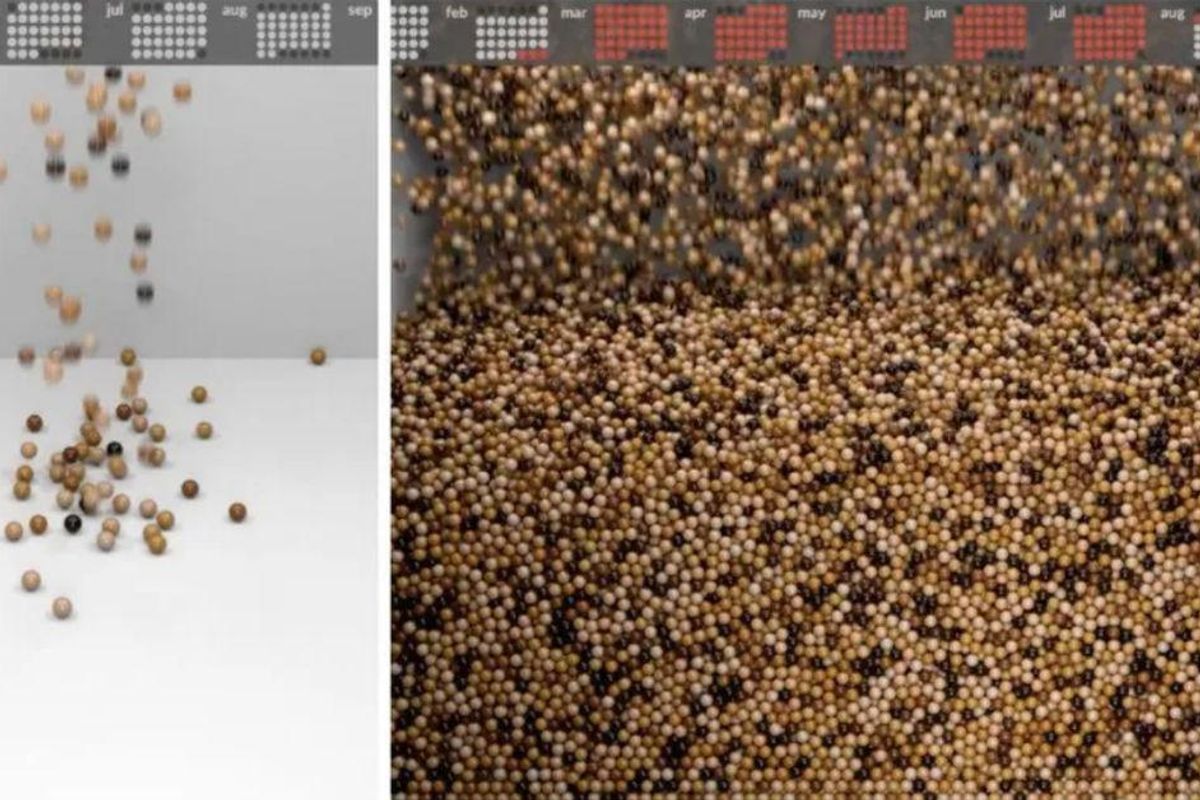An anonymous VFX artist created a chilling visual of the American lives lost to COVID-19

There's a weird thing that happens when we talk about people dying, no matter what the cause. The 2,977 souls who lost their lives in the 9/11 attack felt overwhelming. The dozens of children who are killed in school shootings are mourned across the country each time one happens. The four Americans who perished in Benghazi prompted months of investigations and emotional video montages at national political conventions.
But as the numbers of deaths we talk about get bigger, our sensitivity to them grows smaller. A singular story of loss often evokes more emotion than hearing that 10,000 or 100,000 people have died. Hearing a story of one individual feels personal and intimate, but if you try to listen to a thousand stories at once, it all blends together into white noise. It's just how our minds work. We simply can't hold that many individual stories—and the emotion that goes along with them—all at once.
But there are some ways we can help our brains out. An anonymous visual effects artist has created a visualization that can better help us see the massive number of Americans who have been lost to the coronavirus pandemic. The number alone is staggering, and seeing all of the individual lives at once is overwhelming.
In this video, each marble represents one American who has died of COVID-19, and each second represents six days. At the top, you can see the calendar fill in as time goes by. Unlike just seeing a grid of dots representing the visual, there's something about the movement and accumulation of the marbles that makes it easier to see the scope of the lives impacted.
Just watch:
(If you're curious, the artist has clarified that no, the flesh tones of the spheres are not representative of the racial makeup of those impacted by the pandemic.)
The artist, who you can find on Reddit wrote on Vimeo, "A single death is terrible but something I can comprehend as I have life experience to draw upon. When the number of deaths become 5, 10, 50, [it's] a tragedy and still something I can connect with at a very personal level. However, as death tolls start to hit the 100s it becomes something else. It becomes an event. An awful event. It becomes harder to conceptualize and empathize with. I suspect the threshold for this is different for everyone and varies between cultures. The goal of this project was to help me visualize 230,000 as a number but it also helped reconcile that these are people with families, friends and social circles..."
The artist said they started working on this project on November 1 and finished November 15. During that time, an additional 15,000+ Americans died from COVID-19.
Furthermore, from the time the project was finished to the time this article was written—two weeks—another 22,000+ have died from the virus.
The scope of the tragedy of the pandemic truly is hard to fathom. When you think of the extended circles of people each of these marbles represent—the family and friends of the people who have died from this disease—it becomes even moreso.
And it didn't have to be this way. In the early months of the outbreak, we were told that if we managed the pandemic, we might lose 100,000 to 200,000 Americans total. We've already blown past the top of that range, with our average daily death toll trending upwards. And with hospitals filling up and a limited supply of healthcare workers, we are likely to see those averages spike even further.
We can slow that spike with our own behaviors—staying at home as much as we can, wearing masks when we have to go out, keeping up social distancing and handwashing. But no matter what happens, each of the lives lost to this disease deserves to be recognized for the tragedy that it is. And they each deserve the acknowledgement that we could have and should have done more to keep it under control. We have examples in countries like New Zealand, Australia, Vietnam, Taiwan, and South Korea, who managed to successfully keep the virus at bay and prevent the deluge of deaths that we've seen here.
Let's learn from this experience so the next time a pandemic hits—and there assuredly will be a next time—we'll have a better grasp on what to do from the get go. And let's make sure that hundreds of thousands of Americans dying in a matter of months never become just another statistic.
- A pandemic prep expert's poop-in-the-pool analogy explains ... ›
- Pandemic photos from 1918 show what has changed in a century ... ›
- Misinformation has consequences. In a pandemic, those ... ›
- COVID-19 patient returns to hospital to apologize to staff - Upworthy ›







 Rihanna Nails GIF
Rihanna Nails GIF Stop Right There The End GIF by Freeform
Stop Right There The End GIF by Freeform